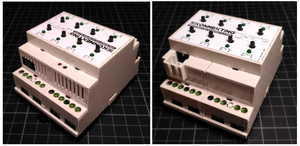DFF4.1
| DFF4.1 | |
|---|---|
| Developer | Alexander Christian |
| Status | Version 1.0 finished |
| Microcontroller/Board | M0dularisM+ |
| KNX connectivity | Siemens BCU, Eugen's µBCU |
Description
The purpose of this actuator is, to control Roto Rototronic skylight with shutters and/or sun blinds. It has 4 "channels". Each channel internally uses two relays: One for the open-action, and one for the close-action.
Of course you can also control your Roto Rototronic skylight with help of a standard switch-actuator. But then you don't have the possibility to "open the window 75%" or "close the shutter 80%". The firmware for DFF4.1 provides all this neat feature that you know from typical shutter/blinds actuators.
Hardware
This actuator consists of the following REG parts:
- M0dularis+
- 8x Button + 8x LED
- 8x Relay Bistable, bus powered (8 relays in total, 2 for each channel = 4 channels).
I2C address on application board:
A0: 1 A1: 0 A2: 0
I2C address on frontend board:
A0: 0 A1: 0 A2: 0
Software
User Documentation
Check here for the DFF4.1 User Manual
Developer Documentation
Firmware sourcecode is on github: https://github.com/KONNEKTING/DFF4.1 Follow this guide for updating the firmare from source-code: KONNEKTING USB Firmware Update
Get a DIY kit
You are interested in this actuator? Great! This device is available as a DIY kit.
The kit includes all required parts with pre-soldered SMD parts and pre-flashed controller board.
You only need:
- soldering iron and solder
- a screw driver
- a sharp knife with a fine tip
- a working KNX installation where you can connect the device to
- ~2-3hrs to build it according to the build instructions linked on this page
- a computer: Windows, Linux or MAC that is able to run KONNEKTING Suite plus a KNX IP Interface or an KNX IP Router.
- for updating the firmware: A Mini USB cable (Not Micro-USB like on your smartphone. Mini USB is a big thicker as Micro USB)
Please write a mail to info@konnekting.de and refer to this page.
Build It
This actuator uses three PCBs, a bunch of SMD components as well as a lot of mechanical parts. As most users are not able to solder SMD, the PCBs are pre-soldered with all SMD components. Due to the big amount of parts, this actuator comes as a DIY kit: You have to solder non-SMD parts yourself and build up the device and finally flash the firmware with help of a USB connection.
Check here for the DFF4.1 Building Instructions
Help
If relays do not work as expected, you can run this test-sketch to be able to switch relais by serial console. Commands follow this syntax:
[a-h0-1]\n
f.i. "a0" disables relay A, "f1" enables relay F On startup all relays are disabled. It is recommended to use this test without attached window/shutter, but with am multimeter/continuity-tester to be able to test relay by relay.
1#include <Wire.h>
2#include <Adafruit_MCP23017.h>
3
4Adafruit_MCP23017 mcp;
5#define LED A5
6#define EN A0
7
8// MCP23017 Output register<->pin map
9#define OA0 0
10#define OA1 1
11#define OA2 2
12#define OA3 3
13#define OA4 4
14#define OA5 5
15#define OA6 6
16#define OA7 7
17#define OB0 8
18#define OB1 9
19#define OB2 10
20#define OB3 11
21#define OB4 12
22#define OB5 13
23#define OB6 14
24#define OB7 15
25
26
27#define A_SET OB1
28#define A_RESET OB0
29
30#define B_SET OB3
31#define B_RESET OB2
32
33#define C_SET OB5
34#define C_RESET OB4
35
36#define D_SET OB7
37#define D_RESET OB6
38
39#define E_SET OA0
40#define E_RESET OA1
41
42#define F_SET OA2
43#define F_RESET OA3
44
45#define G_SET OA4
46#define G_RESET OA5
47
48#define H_SET OA6
49#define H_RESET OA7
50
51void setup() {
52
53 SerialUSB.begin(115200);
54
55 SerialUSB.println("SetupMCP Relais Test ...");
56
57 pinMode(LED, OUTPUT);
58 pinMode(EN, OUTPUT);
59 digitalWrite(LED, HIGH);
60 digitalWrite(EN, HIGH);
61
62
63 mcp.begin(1);
64
65 for (int i = 0; i < 16; i++) {
66 mcp.pinMode(i, OUTPUT);
67 }
68
69 pulseMCP(A_RESET);
70 pulseMCP(B_RESET);
71 pulseMCP(C_RESET);
72 pulseMCP(D_RESET);
73 pulseMCP(E_RESET);
74 pulseMCP(F_RESET);
75 pulseMCP(G_RESET);
76 pulseMCP(H_RESET);
77
78
79 SerialUSB.println("... done");
80
81 // initial delay
82 delay(1000);
83 SerialUSB.println("Initial delay done.");
84 SerialUSB.println("Waiting for command...[a-h0-1]");
85}
86
87//84
88#define WAIT_TIME 84
89
90//16
91#define SET_TIME 16
92
93String cmd;
94
95void loop() {
96
97 cmd = SerialUSB.readStringUntil('\n');
98
99 if (cmd.length() > 0) {
100 SerialUSB.print("Command: ");
101 SerialUSB.println(cmd);
102
103 if (cmd == "a1") {
104 pulseMCP(A_SET);
105 } else if (cmd == "a0") {
106 pulseMCP(A_RESET);
107 }
108
109 else if (cmd == "b1") {
110 pulseMCP(B_SET);
111 } else if (cmd == "b0") {
112 pulseMCP(B_RESET);
113 }
114
115 else if (cmd == "c1") {
116 pulseMCP(C_SET);
117 } else if (cmd == "c0") {
118 pulseMCP(C_RESET);
119 }
120
121 else if (cmd == "d1") {
122 pulseMCP(D_SET);
123 } else if (cmd == "d0") {
124 pulseMCP(D_RESET);
125 }
126
127 else if (cmd == "e1") {
128 pulseMCP(E_SET);
129 } else if (cmd == "e0") {
130 pulseMCP(E_RESET);
131 }
132
133 else if (cmd == "f1") {
134 pulseMCP(F_SET);
135 } else if (cmd == "f0") {
136 pulseMCP(F_RESET);
137 }
138
139 else if (cmd == "g1") {
140 pulseMCP(G_SET);
141 } else if (cmd == "g0") {
142 pulseMCP(G_RESET);
143 }
144
145 else if (cmd == "h1") {
146 pulseMCP(H_SET);
147 } else if (cmd == "h0") {
148 pulseMCP(H_RESET);
149 }
150
151 SerialUSB.println("\n\nWaiting for command...[a-h0-1]");
152 }
153
154}
155
156void pulseMCP(int i) {
157 SerialUSB.print("Pulse at addr #");
158 SerialUSB.print(i);
159
160 mcp.digitalWrite(i, HIGH);
161 delay(SET_TIME);
162 mcp.digitalWrite(i, LOW);
163 delay(WAIT_TIME);
164 SerialUSB.println(" *DONE*");
165}
